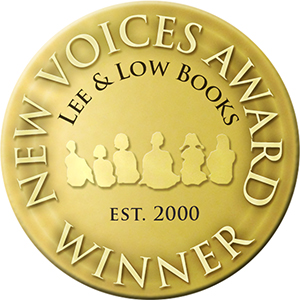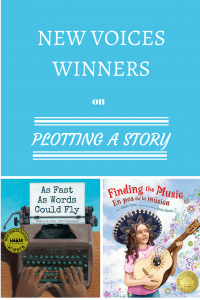 This year marks our sixteenth annual New Voices Award, Lee & Low’s writing contest for unpublished writers of color.
This year marks our sixteenth annual New Voices Award, Lee & Low’s writing contest for unpublished writers of color.
In this blog series, past New Voices winners gather to give advice for new writers. This month, we’re talking about tools authors use to plot their stories.
Pamela Tuck, author of As Fast As Words Could Fly, New Voices Winner 2007
One tip I learned from a fellow author was that a good story comes “full circle”. Your beginning should give a hint to the ending, your middle should contain page-turning connecting pieces, and your ending should point you back to the beginning.
The advantage I had in writing As Fast As Words Could Fly, is that it was from my dad’s life experiences, and the events were already there. One tool that helped me with the plot was LISTENING to the emotions as my dad retold his story. I listened to his fears, his sadness, his excitement, and his determination. By doing this, I was able to “hear” the conflict, the climax, and the resolution.
One major emotion that resonates from my main character, Mason, is confidence. I drew this emotion from a statement my dad made: “I kept telling myself, I can do this.” The challenging part was trying to choose which event to develop into a plot. My grandfather was a Civil Rights activist, so I knew my dad wrote letters for my grandfather, participated in a few sit-ins, desegregated the formerly all-white high school, learned to type, and entered the county typing tournament. Once I decided to use his typing as my focal point, the next step was to create a beginning that would lead up to his typing. This is when I decided to open the story with the idea of my dad composing hand-written letters for his father’s Civil Rights group. I threw in a little creative dialogue to explain the need for a sit-in, and then I decided to introduce the focal point of typing by having the group give him a typewriter to make the letter writing a little easier. To build my character’s determination about learning to type, I used a somewhat irrelevant event my dad shared: priming tobacco during the summer. However, I used this event to support my plot with the statement: “Although he was weary from his day’s work, he didn’t let that stop him from practicing his typing.” His summer of priming tobacco also gave me an opportunity to introduce two minor characters who would later add to the tension he faced when integrating the formerly all-white school.
The second step was to concentrate on a middle that would show some conflict with typing. This is when I used my dad’s experiences of being ignored by the typing teacher, landing a typing job in the school’s library and later being fired without warning, and reluctantly being selected to represent his school in the typing tournament.
Lastly, I created an ending to show the results of all the hard work he had dedicated to his typing, which includes a statement that points back to the beginning (full circle).
Although the majority of the events in As Fast As Words Could Fly are true, I had to carefully select and tweak various events to work well in each section, making sure that each event supported my plot.
Jennifer Torres, author of Finding the Music, New Voices Winner 2011
I’m a huge fan of outlines and have a hard time starting even seemingly simple stories without one. An outline gives me and my characters a nice road map, but that’s not always enough. Once I had an outline for Finding the Music, it was really helpful to visualize the plot in terms of successive scenes rather than bullet points. I even sketched out an actual map to help me think about my main character Reyna’s decisions, development and movement in space and time.
Still, early drafts of the story meandered. There were too many characters and details that didn’t move the plot forward. When stories begin to drift like that, I go back to my journalism experience: Finding the Music needed a nut graph, a newspaper term for a paragraph that explains “in a nutshell” what the story is really about, why it matters. Finding the Music is about a lot of things, but for me, what it’s *really* about is community—the community Reyna’s abuelo helped build through this music and the community Reyna is part of (even though it’s sometimes noisier than she’d like). I think Reyna’s mamá captures that idea of community when she says, “These are the sounds of happy lives. The voices of our neighbors are like music.”
Once I found the heart of the story, it was a lot easier to sharpen up scenes and pull the plot back into focus.








